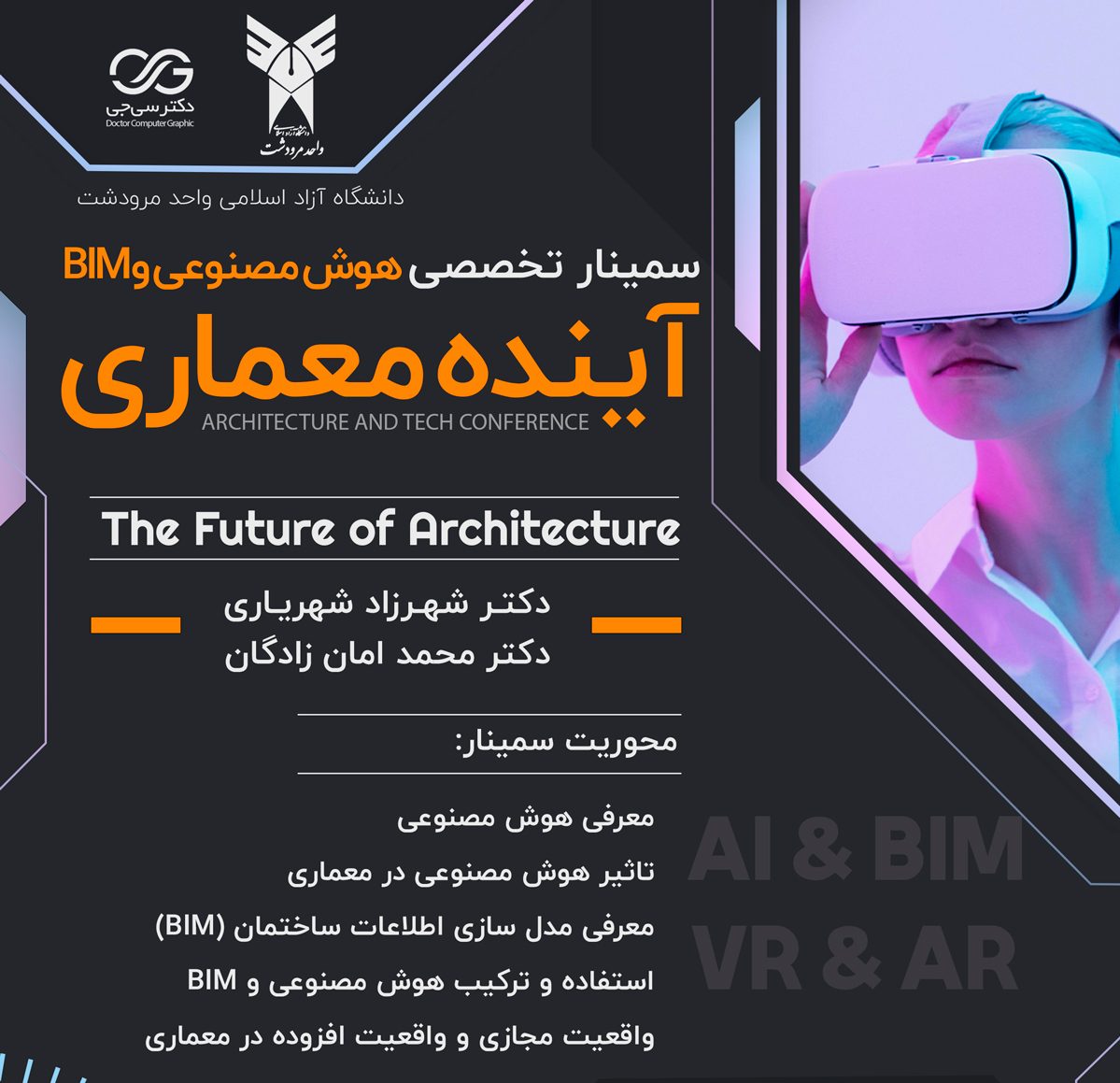
Artificial Intelligence, BIM, AR, and VR: The Future of Architecture Seminar
The Future of Architecture: Artificial Intelligence, BIM, AR, and VR
Mohammad Amanzadegan, a leading expert in the field of artificial intelligence (AI) and building information modeling (BIM), presented a seminar on the future of architecture at the Islamic Azad University, Marvdasht Branch on November 16, 2023.
The seminar covered a wide range of topics, including:
- Introduction to AI
- AI in architecture
- Introduction to BIM
- Using BIM tools
- Combining AI and BIM
- Introduction to AR and VR
- Using AR in architecture and construction
- Using VR in architecture
- Introducing the Unreal Engine architecture toolkit
Introduction:
Artificial intelligence (AI), building information modeling (BIM), augmented reality (AR), and virtual reality (VR) are emerging technologies that have the potential to revolutionize the future of architecture. These technologies can be used to improve the design and construction process of buildings, creating safer, more efficient, and sustainable structures.
Artificial Intelligence
AI is the ability of machines to perform tasks that are typically performed by humans. AI can be used in a variety of fields, including architecture.
In architecture, AI can be used to automate design and construction processes, improve the accuracy and quality of design, reduce construction costs, and increase safety.
For example, AI can be used to automate the process of designing structures. This can lead to increased productivity and reduced costs. AI can also be used to improve the accuracy and quality of structural design. This can lead to reduced errors and increased safety.
BIM
BIM stands for building information modeling. BIM is a new approach to designing, constructing, and managing buildings that is based on the use of three-dimensional models. BIM is used in a variety of fields, including architecture.
In architecture, BIM can be used to improve the design and construction process of buildings, reduce errors, and increase productivity.
For example, BIM can be used to create accurate and realistic three-dimensional models of buildings. These models can be used to improve communication between design and construction teams, reduce errors in the design and construction process, and increase productivity.
AR and VR
AR stands for augmented reality. VR stands for virtual reality. AR and VR are emerging technologies that can be used in a variety of fields, including architecture.
In architecture, AR and VR can be used to provide interactive experiences for users, improve the design of buildings, and train staff.
For example, AR can be used to create an interactive three-dimensional model of a building. This can help users to view the building from different perspectives and interact with it.
VR can be used to create a virtual reality simulation of a building. This can help users to view the building from the inside and outside and interact with it.
Challenges and Opportunities
The use of AI, BIM, AR, and VR in architecture presents both challenges and opportunities.
Challenges
One challenge facing the use of these technologies in architecture is the high cost. These technologies are still in the early stages of development, and the cost of using them is relatively high.
Another challenge is the lack of familiarity of many architects with these technologies. To use these technologies effectively, it requires training and skills. Many architects are still not familiar with these technologies and cannot use them effectively.
Opportunities
Despite the challenges, the use of AI, BIM, AR, and VR in architecture also presents many opportunities.
These technologies can be used to improve the design and construction process of buildings, creating safer, more efficient, and sustainable structures.
For example, AI can be used to automate design and construction processes. This can lead to increased productivity and reduced costs. AI can also be used to improve the accuracy and quality of design. This can lead to reduced errors and increased safety.
BIM is also an emerging technology that can be used to improve the design and construction process of buildings. BIM is based on the use of three-dimensional models. These models can be used to improve communication between design and construction teams, reduce errors in the design and construction process, and increase productivity.
AR and VR are also emerging technologies that can be used in the field of architecture. AR can be used to provide interactive experiences for users. This can help to improve the design of buildings and train staff. VR can be used to create interactive virtual reality experiences. This can help to improve the design of buildings and train staff.
Seminar:
Dr. Amanzadegan began by providing an overview of AI, including its history, development, and applications. He then discussed the potential of AI for transforming the architecture industry.
Dr. Amanzadegan explained that AI can be used to improve the efficiency and effectiveness of architectural design, construction, and maintenance. For example, AI can be used to automate tasks such as 3D modeling, simulation, and analysis. It can also be used to generate new design ideas and solutions.
Dr. Amanzadegan also discussed the potential of BIM for transforming the architecture industry. BIM is a digital representation of a building that includes information about its physical and functional characteristics. Dr. Amanzadeh explained that BIM can be used to improve communication and collaboration between stakeholders, reduce errors, and improve the overall quality of a project.
Dr. Amanzadegan concluded by discussing the potential of AR and VR for transforming the architecture industry. AR and VR can be used to provide immersive experiences that allow users to interact with a building or space realistically. Dr. Amanzadeh explained that AR and VR can be used for a variety of purposes, such as design visualization, training, and marketing.
The seminar was well-attended by architects, engineers, and other professionals interested in the future of architecture. Dr. Amanzadeh’s presentation was informative and engaging, and it provided valuable insights into the potential of AI, BIM, AR, and VR to transform the architecture industry.
Here are some of the key takeaways from the seminar:
- AI has the potential to revolutionize the architecture industry by automating tasks, generating new ideas, and improving communication and collaboration.
- BIM is a powerful tool that can be used to improve the efficiency and effectiveness of architectural projects.
- AR and VR can be used to provide immersive experiences that allow users to interact with a building or space realistically.
Conclusion
The future of architecture is bright with the promise of AI, BIM, AR, and VR. These technologies have the potential to transform the way buildings are designed and constructed. By automating tasks, improving accuracy and quality, and providing interactive experiences, these technologies can help to create safer, more efficient, and sustainable buildings.
The seminar was a valuable opportunity for architects and other professionals to learn about the latest trends in AI, BIM, AR, and VR. It is clear that these technologies have the potential to have a significant impact on the future of architecture.



